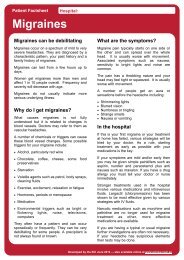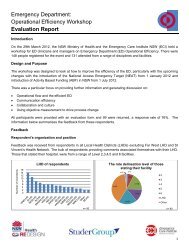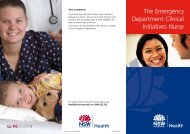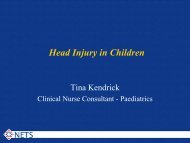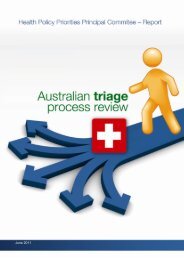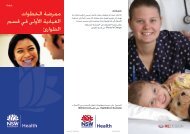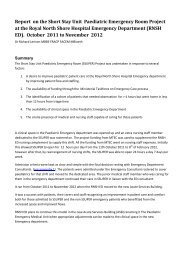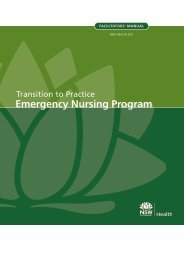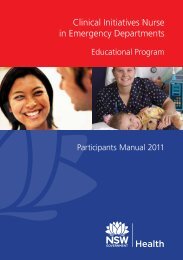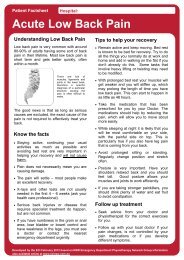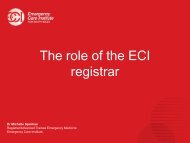Emergency Department Models of Care 2012 - NSW Health
Emergency Department Models of Care 2012 - NSW Health
Emergency Department Models of Care 2012 - NSW Health
- No tags were found...
You also want an ePaper? Increase the reach of your titles
YUMPU automatically turns print PDFs into web optimized ePapers that Google loves.
Key principles ■ This is not a stand-alone model <strong>of</strong> care: it requires the integration <strong>of</strong> patient flow systemsand the physical space to support and sustain it. This integration will include streaming tomodels <strong>of</strong> care within the ED (for example, ETZ, Fast Track, Sub-acute) as well asstreaming options outside <strong>of</strong> the ED (for example, Medical and Surgical Assessment Unitsand other inpatient wards, the Psychiatric <strong>Emergency</strong> <strong>Care</strong> Centre, Hospital in the Homeservices and Outpatients).■■■■■Reallocate the existing ED workforce and physical spaces to provide earlier seniorassessment and care <strong>of</strong> patients.It is essential to:- Assign a senior medical decision-maker for early assessment and disposition decisions toenable all patients to be safely assessed in the Streaming Zone- Limit the patient’s initial assessment by the Senior Medical Officer to < 10 minutes beforebeing streamed into a MOC.- Have robust <strong>Models</strong> <strong>of</strong> <strong>Care</strong> in place within and outside the ED for the ED SAS to streamto.Operate ED SAS at peak periods <strong>of</strong> demand in the ED – the model is designed to beflexible to meet the needs <strong>of</strong> individual EDs and different types <strong>of</strong> patient presentations.Include triage category 3 – 5 presentations and triage category 2 presentations asappropriate.Ensure a one-way directional flow <strong>of</strong> patients with no returning to the waiting room.Benefits <strong>of</strong> the model ■ Reduced triage times with a focus on quick assessment and assigning level <strong>of</strong> urgency■■■■■■■Early senior medical assessment and decision-making with a treatment planReduce the ED length <strong>of</strong> stay by providing better initial decision-making, improving timelyaccess to safe and quality ED careEarly initiation <strong>of</strong> appropriate investigationsReduced time to appropriate treatment, for example, time to antibiotics and analgesiaDevelopment <strong>of</strong> a definitive patient management plan in the Streaming Zone thatimproves the patient’s whole ED journey and will have a flow-on effect for the entire EDReduces the total time in ED for these patients (validated in 3 months <strong>of</strong> data from theWestmead Pilot Project and the subsequent implementation <strong>of</strong> the model, 2011).Senior decision-making at the beginning <strong>of</strong> the ED patient journey has the positive impact<strong>of</strong> more efficient bed utilisation within ED■■■■More meaningful and detailed risk stratification <strong>of</strong> patients from the time <strong>of</strong> arrival in theEDEarly streaming <strong>of</strong> patients to appropriate care areas inside and outside <strong>of</strong> the EDImproved patient and carer experienceThe creation <strong>of</strong> an organised and coordinated way <strong>of</strong> managing ED business to improvethe working environment.<strong>Models</strong> <strong>of</strong> <strong>Emergency</strong> <strong>Care</strong> <strong>NSW</strong> HEALTH PAGE 25




